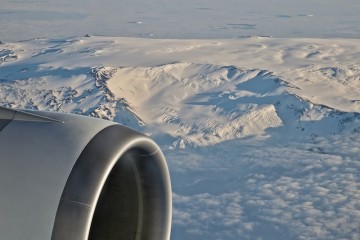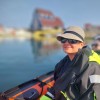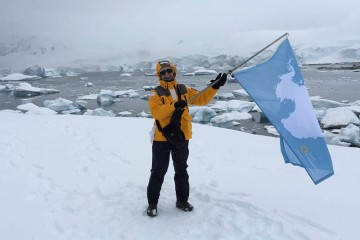Renowned for offering immersive wildlife encounters and extraordinary nature-based adventures, Antarctica expeditions captivate explorers like nothing else on earth. Yet the question of how to reach the remotest continent on earth is ever-present: is it better to fly or cruise to Antarctica? That is the one logistical conundrum many people ponder.
All up, you have three options to visit Antarctica:
-
Return cruise to Antarctica – The classic route sees you join an expedition ship in South America, tackle the Drake Passage, and enjoy a weeklong exploration of the Antarctic Peninsula before tackling the Drake again and heading back.
-
Fly one way – If you wish to experience one Drake Passage crossing (but not two!), you can fly once. Fly down and cruise back, or vice versa.
-
Return flight to Antarctica – This is undoubtedly the best of both worlds for those who dream of experiencing an expedition cruise to Antarctica but fervently wish to skip the Drake. Fly to King George Island, cruise the Antarctic Peninsula, and fly back.
Deciding whether to fly or cruise to the White Continent ultimately depends on personal preference. However, there's a surprising number of pros and cons that many don't consider before making their final choice. Are you short on time or easily suffer from seasickness? Is your travel time set in stone? Do you have flexibility, but is your budget limited? These are the kinds of considerations you ought to make before locking down a definitive option.
In this article, we’ll provide a comprehensive rundown of the benefits and drawbacks of flying or cruising to Antarctica to help you decide which one's best for you.
If there's one thing you can count on, however, it is that no matter which way you get to Antarctica, you are bound to have a life-changing and soul-stirring experience.
Antarctica is the cake. Everything else is just icing!
Here's what we'll cover in this guide:
- Fly or cruise to Antarctica - an Overview of Your Options
- Where do you land when you fly to Antarctica?
- Benefits of a Fly-Cruise to Antarctica
- Drawbacks of a Fly-Cruise to Antarctica
- Benefits of Cruising to Antarctica
- Drawbacks of Cruising to Antarctica
- A Note on the Environmental Impact of Flying and/or Cruising to Antarctica
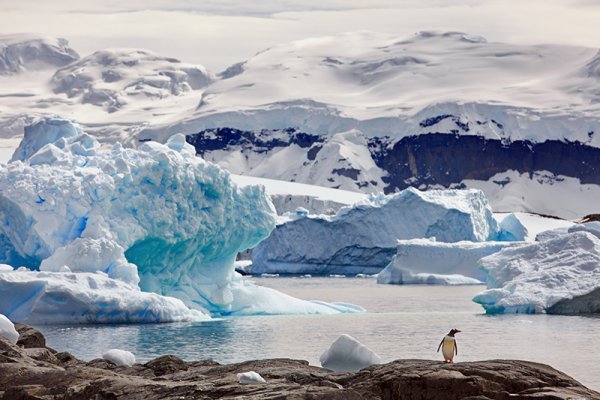
Antarctica’s Gentoo penguins don’t mind how you get to Antarctica – just as long as you come and see them!
Fly or cruise to Antarctica - an Overview of Your Options
Antarctica lies just over 1,200km off the southernmost tip of South America. What separates the two continents is the Drake Passage, a body of water renowned for being unpredictable and among the roughest seas on earth. A crossing of the Drake by expedition cruise ship is revered and feared in equal measure – the former by thrill-seeking adventurers and the latter by anyone who easily suffers seasickness.
What kind of crossing you'll have is anyone's guess. Will it be a Drake Lake or Drake Shake? Even the most experienced expedition captain cannot predict that until the last minute. This is, for many, part of the excitement of cruising to Antarctica.
Yet just as many people turn lime green at the mere thought of a 2-day ship crossing in rough waters. To them, the idea of flying to Antarctica and bypassing the Drake is nirvana personified. We've had passengers tell us they wouldn't go to Antarctica unless they could fly there. For them, this option is essential.

Drake Shake or Drake Lake? That’s the thrilling cruising gamble (for some)!
Where do you land when you fly to Antarctica?
Flights to Antarctica depart from Ushuaia (Argentina) or Punta Arenas (Chile) and land on King George – part of the South Shetland Islands group – about 120km off the shores of the Antarctic Peninsula. From here, passengers join a cruise ship to explore the Antarctic Peninsula.
When talking about ‘flying to Antarctica’, it's essential to understand that 'some' cruising will always be involved. You can fly to and from King George, but you will still need to join an expedition cruise to visit penguin colonies, historical sights and see all those fantastic icebergs. Yet, by then, you’ll be in relatively protected waters and can look forward to a delightful cruising experience.
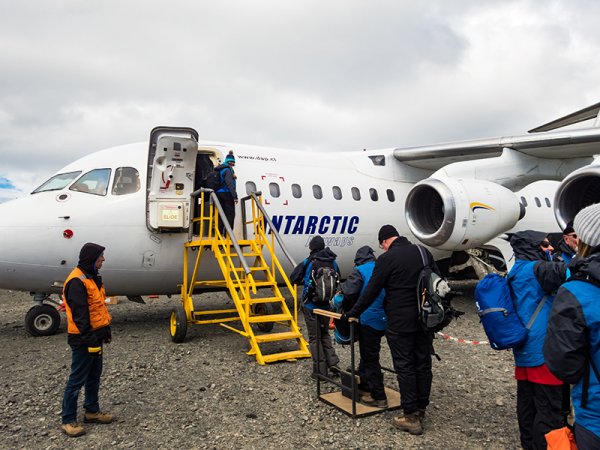
King George Island – just a swim stroke north of Antarctica Peninsula.
Flying to Antarctica means skipping the (potentially) roughest sea crossing but still enjoying the magic of expedition cruising around the frozen continent. Whether you choose to fly to Antarctica or not, cruising is always included.
When deciding if you should fly and/or cruise to Antarctica, your propensity for seasickness should not be the only consideration.
Here are the pros and cons of flying or cruising to Antarctica.
Benefits of a Fly-Cruise to Antarctica
Aside from skipping the Drake and dodging a potential bout of seasickness, a fly-cruise to Antarctica saves time. Opt for a return flight, and you can shave up to five days of travel off your itinerary. For those on a very tight schedule, that could mean the difference between visiting Antarctica and not. A Classic Antarctica cruise, the shortest possible, lasts 11 days, whereas an Express Antarctica – Fly the Drake takes eight days, and Antarctic Express Air-Cruise only six days, door to door.
Another underrated bonus of flying to King George is that you get a magnificent bird's eye view of King George Island when the weather plays along, an incredible privilege not afforded to cruise passengers.
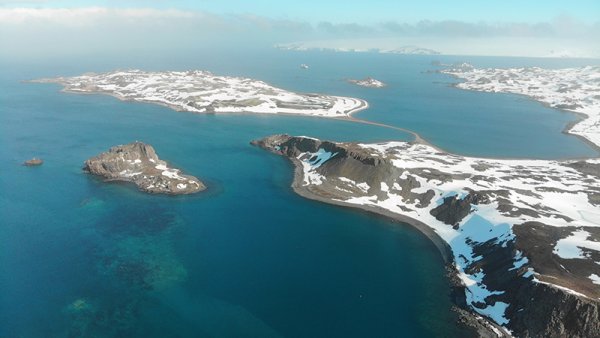
Quite the exceptional bird’s eye view!
Drawbacks of a Fly-Cruise to Antarctica
Fly-cruise options to Antarctica are typically more expensive (or rather less cost-effective) than classic cruises due to the exclusivity of the flight experience. The airport on King George Island is remote and costly to maintain. Plus, it has no 'scheduled' commercial flights. Every flight is chartered (specifically for fly-cruise passengers), adding to the heightened cost.
Flying to Antarctica also means placing your travel dreams in the hands of the weather gods. Flights are much more susceptible to adverse weather conditions than strengthened expedition ships. Poor visibility or strong winds can delay or cancel flights. However, fly and cruise expeditions have built-in flexibility, as they have a few days' buffer to account for potential flight disruptions. The risk of delays due to the weather can counteract the time-saving advantage of flying, so this needs to be considered.
Then there’s the issue of limited departures, itineraries, and availability of both flights and expedition ships. If cruising from South America, your choice of departure dates and ships is bountiful. On King George Island, not so much. Few flights operate per cruising season, and only a select number of cruise ships are on hand to pick up flying passengers. This means you are bound to whatever size of the vessel, level of luxury, and comfort class is available.
Moreover, most cruising options departing King George are limited to the Antarctic Peninsula.
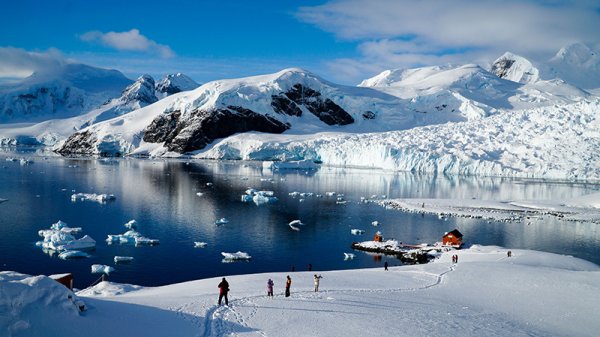
The Antarctica Peninsula is breathtaking all over – yet the further you travel, the more magical the landscapes.
Benefits of Cruising to Antarctica
Embarking on a traditional cruise to Antarctica offers its own set of advantages. The voyage across the Drake Passage is an absolute adventure in itself, providing an opportunity to spot seabirds, whales, and marine life.
Cruises often include onboard educational programs and expert lectures, enhancing your understanding of Antarctica's unique ecosystems and history. When you spend the first two days at sea, there's more time to soak up the experience and build up camaraderie between passengers. Plus, the slower pace of a full cruise allows for a more immersive experience, enabling you to truly appreciate the vastness and tranquillity of the Antarctic landscape.
Cruising also allows for more adaptability to changing weather conditions. Not only can expedition ships handle adverse weather conditions, but ships can navigate to alternative landing sites if necessary.
While both flying and cruising options offer opportunities to spot Antarctica's unique wildlife, cruising provides a broader array of itinerary options. Cruises departing South America can include additional destinations, such as South Georgia & The Falkland Islands, offering extended wildlife encounters and diverse ecosystems.
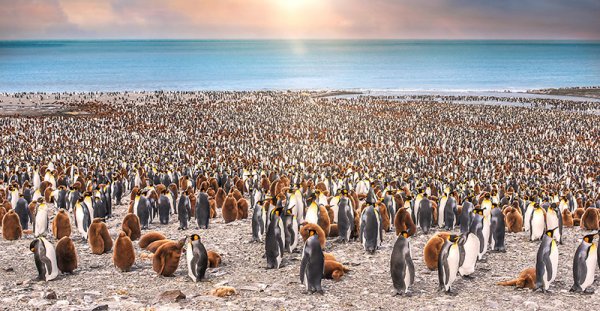
South Georgia boasts the world’s largest number of King Penguin colonies – about 50% (450,000 pairs) of the planet’s giant birds live here! Seeing this spectacle is, for many, reason enough to cruise to Antarctica.
Drawbacks of Cruising to Antarctica
The single and most obvious drawback of a full cruising experience is the potential for a rough crossing of the Drake Passage – and its consequential seasickness risk, as explained above. Cruises are longer, of course, so itineraries include four full days at sea. Not everyone who dreams of an expedition to the southernmost continent is an avid seafaring explorer. For those who wish to spend as little time cruising as possible, a longer cruise might not seem all that appealing.
Other than that, the two experiences (cruise or fly) are identical because they converge on the Antarctic Peninsula. Whether you fly or cruise, you will still need to reach the southern tip of South America, and include a few extra days to your itinerary to buffer last-minute cancellations.
A Note on the Environmental Impact of Flying and/or Cruising to Antarctica
Sustainability and responsible tourism are crucial considerations when visiting Antarctica, and many people also wonder if one option is more environmentally friendly.
Both flying and cruising have environmental impacts, as all traveling generally does. Flying consumes fossil fuels, albeit for a shorter duration. Cruising requires a more extended journey, but modern expedition vessels employ advanced technologies to minimize their environmental footprint. The most important choice is which operator you’ll go with – make sure your Antarctica fly-cruise operator adheres to the International Association of Antarctica Tour Operators (IAATO) regulations and is committed to sustainable practices, such as following strict waste management guidelines.
Tourism can be a source of good for protecting the environment. Every Antarctica expedition is a journey of scientific discovery and understanding. Everyone who's ever been lucky to have visited the southernmost continent on earth goes home to be a genuine ambassador for its protection and of its incredible wildlife. Visit with a responsible operator, experience the breathtaking magic of Antarctica, and you'll enjoy a profound connection to one of the world's most extraordinary environments.
At Viva Expeditions, we take great pride in offering a comprehensive array of Antarctica Expedition Cruises, be they cruise only or fly cruise. Need some more personalized help deciding which one’s best for you? Reach out to our Destination Specialists and they’ll help you find your ideal way of reaching the southernmost continent on earth.
Laura Pattara
Laura Pattara has spent more than a decade writing about polar cruising at Viva Expeditions. While she has not yet set foot on the southern ice herself, she has mastered the art of turning expert accounts and field notes into guides that feel like the next best thing. Laura has a soft spot for penguins, perfectly packed duffel bags, and a well-earned cocktail in a wild place.
|
